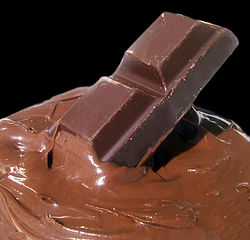Theobromine
Theobromine is a chemical substance, also known as xantheose.[1] It is an alkaloid. It occurs in the cacao plant. Chemically, it is very similar to caffeine.[1] Because the cacao plant is used to make chocolate, it is also found in chocolate. Despite its name, there is no bromine in it. The name "theobromine" comes from the word "Theobroma" as the name of the genus of the cacao tree (which itself is made up of the Greek roots theo ("God") and brosi ("food"), meaning "food of the gods")[2] with the suffix "-ine" given to alkaloids and other base nitrogen-containing compounds.[3]
Theobromine is a water-insoluble, crystalline, bitter powder. Its colour is listed as either white or colourless.[4] It has a similar, but smaller, effect to caffeine, making it a lesser homologue. Theobromine is an isomer of theophylline as well as paraxanthine. Theobromine is categorized as a dimethyl xanthine,[5] which means it is a xanthine[6] with two methyl groups.[7]
Theobromine was first isolated from the seeds of the cacao tree in 1878[8] and then shortly afterwards was synthesized from xanthine by Hermann Emil Fischer.[9]
Theobromine is poisonous to dogs.[10]
Theobromine Media
A chocolate bar and molten chocolate. Chocolate is made from the cocoa bean, which is a natural source of theobromine.
Caffeine is metabolized in the liver into three primary metabolites:*paraxanthine (84%), theobromine (12%), and theophylline (4%)[source?]
References
- ↑ 1.0 1.1 William Marias Malisoff (1943). Dictionary of Bio-Chemistry and Related Subjects. Philosophical Library. pp. 311, 530, 573. B0006AQ0NU.
- ↑ Bennett, Alan Weinberg; Bonnie K. Bealer (2002). The World of Caffeine: The Science and Culture of the World's Most Popular Drug. Routledge, New York. ISBN 0415927234. (note: the book notes that the name "Theobroma" is derived from Latin, rather than Greek)
- ↑ "-ine." The American Heritage® Dictionary of the English Language, Fourth Edition. Houghton Mifflin Company. 2004. ISBN 0395711460.
- ↑ "theobromine". Dictionary.com. Retrieved 2007-02-22.[dead link] For convenience, the direct source of the three definitions used has been cited.
- ↑ "Theobromine". On-Line Medical Dictionary. Retrieved 2007-02-23.
- ↑ "Xanthine". On-Line Medical Dictionary. Archived from the original on 2008-01-05. Retrieved 2007-02-23.
- ↑ "Dimethyl". On-Line Medical Dictionary. Retrieved 2007-02-23.[dead link]
- ↑ Walter Sneader (2005). Drug Discovery: A History. John Wiley & Sons. ISBN 0471899801.
- ↑ Thomas Edward Thorpe (1902). Essays in Historical Chemistry. The MacMillan Company.
- ↑ "Merck Manual Veterinary Manual". Merck Sharp & Dohme Corp., a subsidiary of Merck & Co., Inc. Retrieved 2019-06-28.


